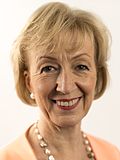| ||||||||||||||||||||||||||||||||||||||||
| ||||||||||||||||||||||||||||||||||||||||
| ||||||||||||||||||||||||||||||||||||||||
The 2016 Conservative Party leadership election was held due to Prime Minister David Cameron's resignation as party leader. He had resigned after losing the national referendum to leave the European Union. Cameron, who supported Britain's continued membership of the EU, announced his resignation on 24 June, saying that he would step down by October. Theresa May won the contest on 11 July 2016, after the withdrawal of Andrea Leadsom left her as the sole candidate.
Conservative members of Parliament had voted initially in a series of ballots to determine which two candidates would go forward to a nationwide ballot of Conservative Party members for the final decision. Five Conservative MPs put themselves forward as candidates: Justice Secretary Michael Gove, Work and Pensions Secretary Stephen Crabb, former Defence Secretary Liam Fox, Minister of State for Energy and Climate Change Andrea Leadsom, and Home Secretary Theresa May. Former Mayor of London Boris Johnson, seen as the front runner by political analysts,[who?] surprised many commentators[who?] by choosing not to run after Gove withdrew his backing and announced his own candidacy.
In the first-round ballot, May, gaining the support of half of Conservative MPs, was placed first with Leadsom in second place. Fox was eliminated on the first ballot; Crabb withdrew later that day. Gove was eliminated in the second round of voting. Before the Conservative Party members were due to cast their votes, Leadsom withdrew from the contest on 11 July.[1] May was appointed party leader later that day, and prime minister on 13 July. She appointed Boris Johnson, Fox and Leadsom to her Cabinet, respectively as Foreign Secretary, international trade secretary, and environment secretary.
If not for Leadsom's withdrawal, Conservative Party members would have directly elected a new prime minister for the first time; this is what happened in the next Conservative leadership election in 2019.
- ^ "Andrea Leadsom pulls out of Conservative leadership race". The Guardian. 11 July 2016. Retrieved 14 September 2022.




